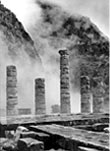Voula Papaioannou began working as a photographer during the 1930s, concentrating at first on studies of landscapes, monuments and archaeological exhibits. The outbreak of war in 1940 marked a turning point in her career, as she was especially effected by the suffering of the non-military population of Athens. Knowing that her camera had the power to arouse consciousness, she documented the troops' departure for the front, the preparations for the war effort, and the care offered to the first casualties of the conflict. When the capital was gripped by starvation, she revealed the horrors of war in her moving photographs of emaciated children. After the liberation, as a member of the photographic unit of UNRRA (United Nations Relief and Rehabilitation Administration), she toured the ravaged Greek countryside recording the difficult living conditions faced by its inhabitants. She often went beyond the bounds of her responsibilities, immortalising the faces and personal stories of everyday people in photographs which stress dignity rather than suffering. During the 1950s Papaioannou's work expressed the optimism which prevailed in the aftermath of the war, both in respect of the future of mankind and the restoration of traditional values. Nevertheless, her photographs of the historic Greek landscape are not in the least romantic, but reveal it instead as harsh, waterless, drenched in light, and inhabited by proud and independent people, despite their poverty. Voula Papaioannou's work represents the trend towards "humane photography" that arose as a result of the abuse of human rights during the war. Her camera captured her compatriots' struggle for survival with respect, clarity and a degree of personal involvement that transcends national boundaries and reinforces confidence in the strength of the common man and the intrinsic value of human life. |

 |
|
© 2000, the Benaki Museum
Home page -
The Museum -
Collections -
Exhibitions/Events -
Archives -
Education
Information -
Publications -
Library -
Museum shop -
Site Map
















